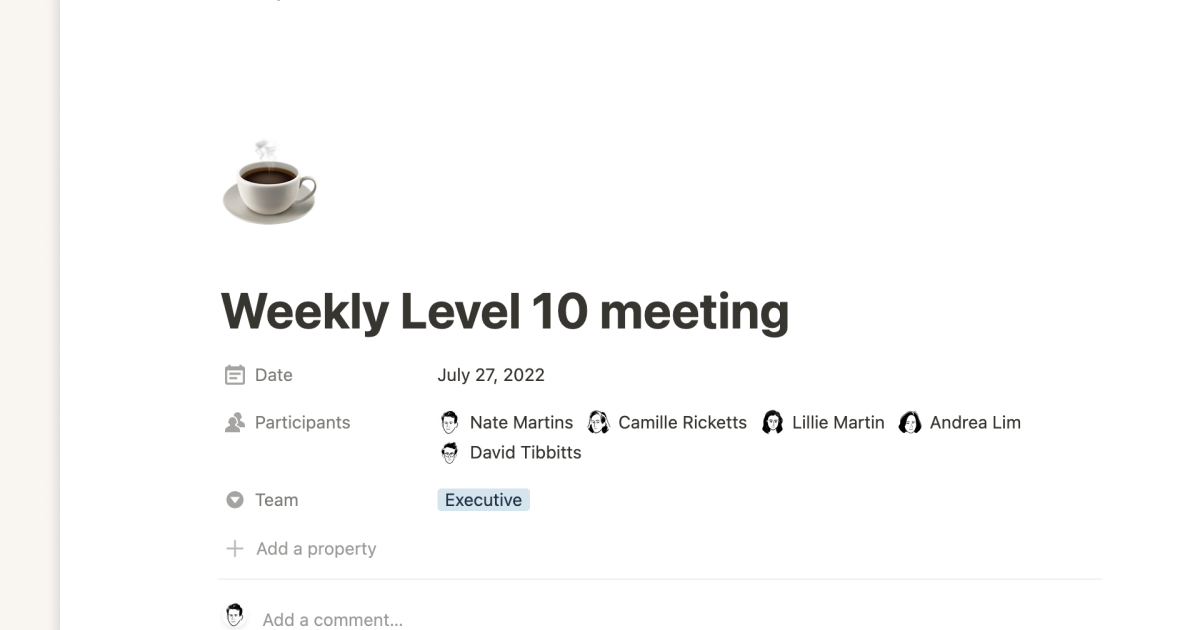As your business grows, you’re bound to lose touch with some of your coworkers. But an effective business isn’t a collection of strangers — it’s a team. So what can you do to keep everyone close, motivated, and informed?
Enter: the all-hands meeting.
It’s easy for departments, teams, and individuals to get wrapped up in their individual tasks and lose sight of the bigger picture. Between new hires, growing departments, and internal promotions, personnel shifts constantly and there are likely people you rarely cross paths with day-to-day — if at all. An all-hands meeting gathers everyone in the organization and ensures leaders and employees from different departments can share their experiences, talk through roadblocks, and keep up-to-date with company progress.
Rounding up every team member for a single meeting might sound too busy to be beneficial, but these discussions are often incredibly productive. Let’s explore what an all-hands meeting is and why these summits are invaluable.
What’s an all-hands meeting?
An all-hands meeting is a recurring gathering for everyone at an organization. Sometimes called a town hall, these events aim to bring together the entire “town”: management, stakeholders, and employees. “All hands” is a nod to the maritime phrase “all hands on deck,” which implies every crew member pitching in.
While all-hands meetings seem manageable at small organizations, larger companies might find bringing hundreds of people into a room formidable. But these meetings, no matter the size, have much to offer. Here, leaders share important periodic updates, celebrate achievements, and remind everyone on staff of the goals and spirit that drive the operation. All-hands meetings are also excellent for employees to surface large-scale questions about the organization’s operations and progress to leadership they might otherwise rarely see.
Why are all-hands meetings beneficial?
It’s true: all-hands meetings can’t tackle every milestone, hurdle, and question participants wish to share without running overtime. That said, they lay an essential foundation for camaraderie and productivity.
Here’s why these employee meetings are beneficial:
Everyone’s on the same page — one of the primary functions of an all-hands meeting is to update all company employees efficiently. Even if the meeting only accomplishes sharing important company news, it’s already working. These updates cue employees into changes that affect their jobs and acknowledge achievements they can feel proud of taking part in, leading to a more excited and engaged workforce.
Time for questions — an entry-level employee rarely gains the opportunity to talk to a member of the C-suite. But an all-hands meeting makes this interaction possible. Part of the magic of these gatherings is that an otherwise introverted employee in a non-leadership role could present a question or thought that spurs change or a new project.
Company culture — all-hands meetings don’t have to focus entirely on business: there can be an aspect of fun, too. These gatherings allow company leaders to run dynamic activities that encourage connections. Plus, a little play also does a lot for boosting morale.
What should go on an all-hands meeting agenda?
When teams meet, the objectives are clear: discussing progress, roadblocks, and milestones. But forming an agenda is more challenging when a company meeting brings all the employees together. What information benefits tens — if not hundreds — of people from different departments and levels of the company?
Here are common meeting topics to discuss in an organization-wide gathering:
A clear theme — while not every all-hands meeting needs to have a finite focus, pinpointing an overarching topic keeps everyone on track. For example, companies adapting their ways of working to unexpected changes in the marketplace can make these shifts the theme of the meeting. Similarly, a business considering changing policies (like a move to a four-day workweek) can take advantage of this meeting to gather insights from affected employees.
General updates — leadership can provide statistics on recent company performance, such as quarterly financials. Employees invest in the operation’s success and want to know how their efforts pay off, so they appreciate being in the loop.
A moment of celebration — all-hands meetings should take time to highlight company achievements or exceptional work. This platform provides an opportunity for leaders to recognize employees who’ve excelled.
Time for questions and comments — after presenting changes, milestones, and performance metrics, employees may have questions or an encouraging word to add. Use all-hands meetings to surface doubts like, “What do these overall changes mean for the marketing department?” or kudos such as, “I’m so glad you’re recognizing Tom’s efforts. His long hours helped the development team meet deadlines.”
How to host a productive all-hands meeting
The purpose of staff meetings isn’t to waste people’s time. These gatherings should be community-building, orienting, and — above all — productive. So, how can leaders structure a meeting worth attending? Following this step-by-step guide to hold an all-hands meeting that employees won’t wish had been an email:
1. Give employees a heads-up
Encourage participation by sending out an invitation in advance. All-hands meetings should happen regularly so participants expect them (and the invitation is simply a reminder). Before holding your first gathering, choose a meeting cadence, like every third Friday of the month. Decide on a time that won’t interrupt essential work so the whole team can attend. And if you have international staff, be mindful of time differences when scheduling.
2. Create an agenda and materials
Plan the theme of the meeting and core talking points, and create supporting materials (such as slides and an agenda) around them. Preparedness ensures speakers don’t run over time and employees have room to ask questions, connect, and have fun. Plus, visuals help participants understand critical ideas quickly and appreciate metrics. Think: a graph that shows an impressive quarterly sales boost.
3. Test your tech
Chances are that at least one employee (if not hundreds) will connect from their home office. So, test your tech for the virtual aspects of the meeting. Ensure clear audio, visuals, and a stable internet connection. For the in-person version of the meeting, make sure that mics, speakers, and projectors work before beginning.
4. Assign a moderator and speakers
Ask a company leader to “MC” the event. This should be a person with strong public speaking skills who can keep the meeting on course. And be sure to tap speakers for different topics during the all-hands. Have the sales director provide information on performance or an IT manager explain an exciting new development project to connect teams.
5. Celebrate
Leave time for celebration. Acknowledge the company’s achievements since the last meeting and noteworthy employee performance. You may wish to devise a specific employee-of-the-month-style recognition program so people know what to look forward to.
6. Open the floor
Round out the meeting with questions. Have a time limit and a clear plan for fielding ideas and concerns. Try having people fill out a form with questions before the meeting so that you can synthesize trends and speak to those themes. This may be more efficient than having people raise their hands — especially in larger organizations.
What about remote all-hands sessions?
Remote all-hands meetings have the same spirit and goals as in-person ones. But remote or hybrid gatherings require a few special considerations. Use the following guide to pull off a staff meeting with purpose — even if your team’s spread out:
Invest more time announcing the meeting — unlike an all-hands meeting that’s right down the hall, remote employees won’t see their peers heading to an event and join in. It’s important to announce the meeting via several channels like your team calendars, email, and internal messaging applications. Include the login meeting link everywhere so people can access it without digging through their inboxes.
Prepare your speakers — remote videoconferencing apps have methods for switching speakers and allowing screen sharing and commenting. Ensure all-hands speakers are clear on these features. This way, speakers can take the reins when it’s their time to talk without battling sound or visual issues.
Remember that attention spans may be lower — it can be tougher for people to focus at a remote meeting than at an in-person one. There may be distractions in their home office, like a pet that wants some attention, or on their device, like incoming emails. Prepare for this challenge by making the meeting as interactive as possible.
Hold better meetings with Notion
Notion believes that collaboration drives better projects. That’s why we created a platform around helping teams connect. We’ve also built a library of resources on running a successful business with plenty of guides and templates to facilitate better meetings.
Use our meeting notes template to jot down essential points and learn how to connect those notes to your projects. Plus, learn about other types of meetings that can improve connections and quality of work, like level 10 meetings, daily standups, project goals planning sessions, and kick-off events.






